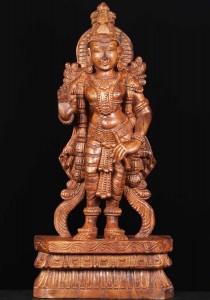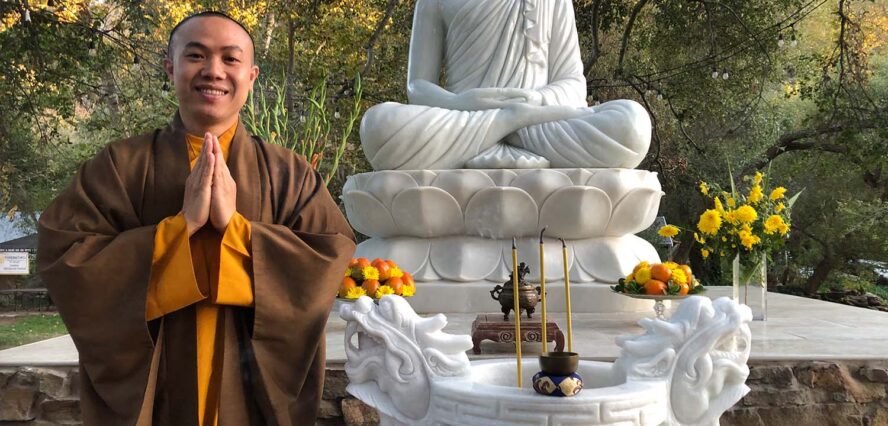
I remember the first time Tai came into our warehouse. I was instantly drawn to him and his bright youthful smile. He was dressed in his mustard-colored monk’s robes with a brown shawl. He radiated bliss and happiness. He walked around the warehouse like he had been there a thousand times before, laughing as my dog, Oso, came up to greet him with a sniff, and taking pictures with my employee, Mark. He was looking for a Buddha statue for the main shrine of his new Temple in Valley Center, Dharma Mountain and Forest Meditation Temple (Thiền Viện Pháp Thuận). He was the happiest person I had ever met.
Since that first meeting, Tai has become a regular here at Lotus Sculpture. Over the years we have made several deliveries of temple sculptures to Dharma Mountain including a large 7 foot meditating Buddha sculpture that is nestled under a tree in their large open front yard. More recently, we delivered a large incense urn to be placed in front of the Buddha. It has been a pleasure visiting Tai over the years and watching the temple grow.
I have a deep sense of peace and contentment whenever I am in the open spaces of the temple with Tai. Oso is always welcome to join me. He runs freely on the grounds and has even jumped into the temple pond for a quick swim.
I always comment on the lifelong relationships I have developed with my artisans. The relationships that have blossomed between my customers and I have been just as valuable and have brought Tai’s blissful disposition into my life. For that, I am forever grateful.
~Kyle Tortora, Founder, Lotus Sculpture
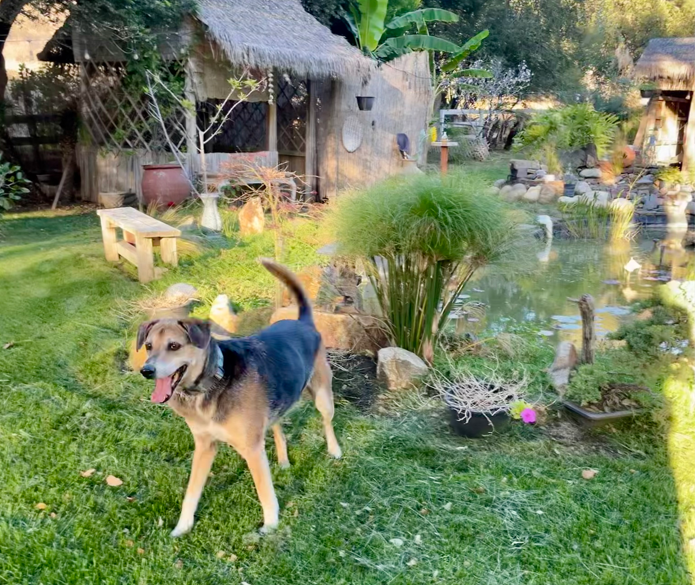
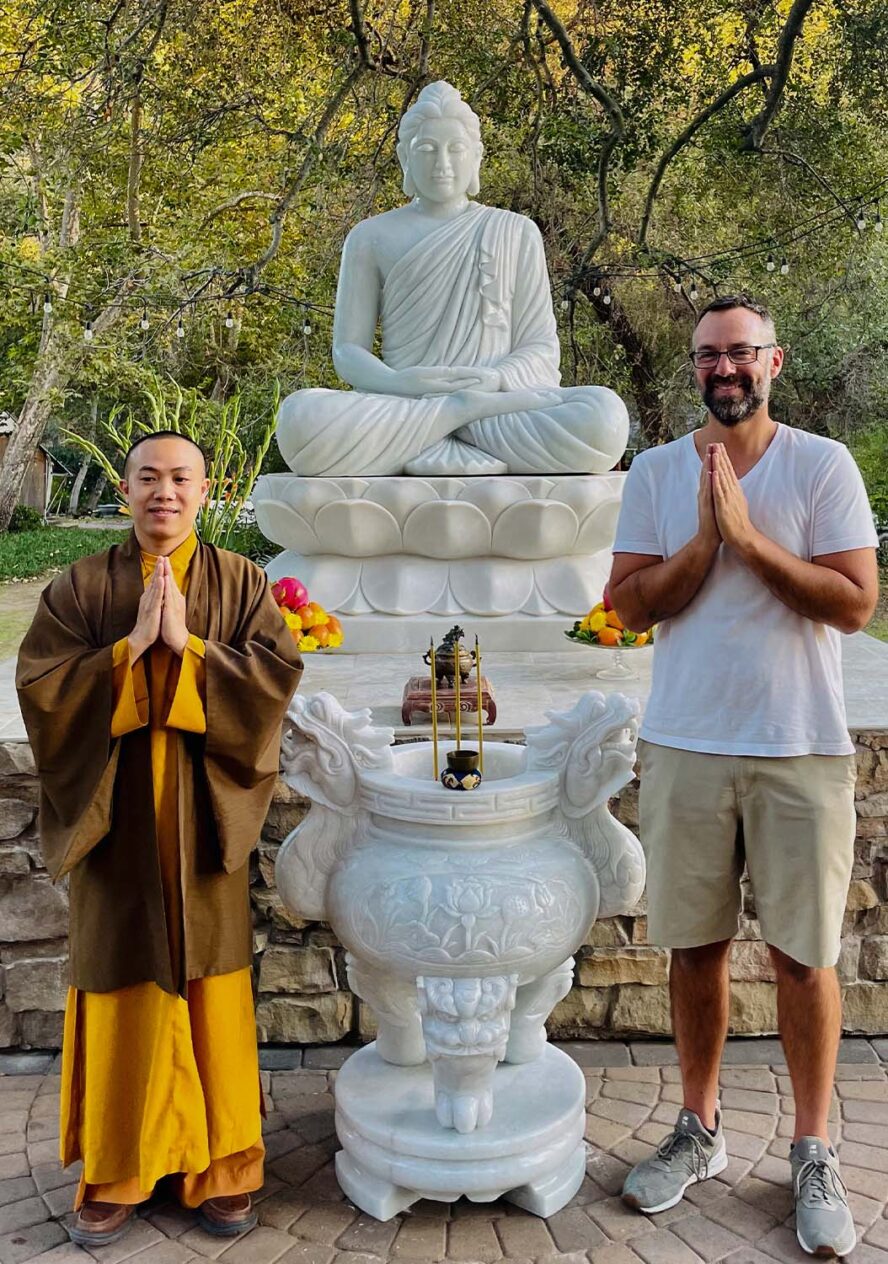
Madurai’s Meenakshi – Sundaresvara Temple, The Gem of Indian Temples
The temple town of Madurai is most famous for the Meenakshi – Sundaresvara temple. This temple dates back to the early centuries of the first millennium, but the intricate and magnificent temple complex that exists today was built between 1623 and 1655 CE. The vast temple complex is home to fourteen monumental towers, or gopurams, as well as some 40,000 individual sculptures chronicling scenes from Hindu mythology. Entering through the east gopura, visitors are greeted by the eight forms of the goddess in the Ashta Sakti mandapa. Passing the intricately carved pillars donning the goddess in eight beautiful forms, you arrive at the Muthupillai mandapa named after its donor. This is a wide and dark hall filled with sculptures of Shiva in his various forms. The small rays of light that seep through openings in the granite ceiling make for an enchanting and ethereal experience. Exiting this hall, you are immediately greeted by the bright sunlight and the open courtyard containing the Golden Lotus Pond.

In the middle of this quaint tank, there is a beautiful hundred petal lotus covered in gold. Along the portico, on the way to the main shrine, are beautifully painted murals narrating 64 glorious exploits of Shiva as referenced in the Tamil magnum opus Tiruvilayadal (divine game). The most famous of these is one depicting the celestial marriage of Meenakshi, a form of Parvathi, with the beautiful Siva, or Sundaresvara. The next stop is the Killikoondu mandapa, or the corridor of bird cages. Up until a few decades ago, this hall was filled with hundreds of parrots, considered very dear to the goddess. North of this corridor is the altar of Ganesha. Just beyond this altar resides Goddess Meenakshi in all her regal splendor.
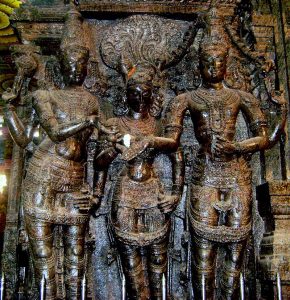
The entire corridor around her sanctum sanctorum is richly decorated with intricate stone carvings and beautiful gold relief work. Inside the Garbha Gruha, literally the womb-house stands the Goddess Meenakshi, carved from a single large emerald stone. Her left-hand hangs gracefully by her side, while her right-hand holds a golden lotus upon which a gold parrot stands. North of her chamber resides her consort Sundaresvara, surrounded by a hall containing gargantuan pillars embellished with carvings of his various forms. The most famous of these is the depiction of the marriage of Meenakshi-Sundaresvara, facilitated by Meenakshi’s brother, Lord Vishnu. Just before exiting the temple, you meet the thousand pillared halls, boasting a beautiful statue of Nataraja and his consort Sivakamasundari, as well as numerous carved pillars depicting the Hindu epics like the Mahabharata.
The famous scene of the sacred marriage is described in the Saiva Karanagama as follows: Lord Shiva shines beautifully like bright saffron. He has three eyes, and four hands. He is adorned with fresh flower garlands and exquisite gold ornaments. His entire body is draped with fine silk garments.
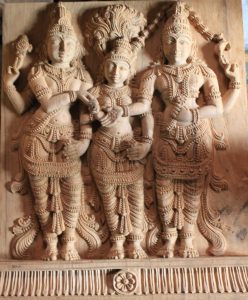
His hands are decorated by jeweled bangles and gold lotuses. He holds the hand of Parvathi with one hand and the ax and deer in his other two. The Lord gleams with the effulgence of a thousand bright suns. He has matted dreadlocks and a diamond-studded crown, embellished by the moon. The Goddess stands next to Shiva, holding his hand. She is decked with the most elegant red silk. Her chest bends slightly due to the weight of her many pearls, gold, ruby, emerald, sapphire, and diamond necklaces. She is adorned with Champa and jasmine flowers in her dark hair. She gleams like dawn. Her brother, Lord Vishnu, pours the holy water on their joined hands to consecrate the divine matrimony. The three stand beautifully under the golden kadamba tree, in the forest of kadamba (Madurai).
-Svasti-
Lord Ayyappa – Son of Vishnu & Shiva
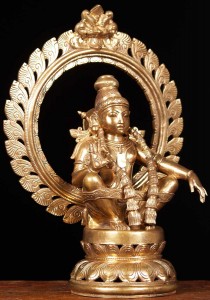
Sabarimala in Kerala, is the site of the most famous Ayyappa temple in the world and is visited by more than 50 million devotees each year, from different parts of the world regardless of their caste, creed and religion.The temple is situated in the middle of a dense forest, and the devotees need to take a 41 day penance, carry irumudi and ascended 18 steps to seek the blessings of the Lord. The story of Ayyappa is depicted in the famous purana, named Bhoothanaathopaakhyaanam.
Birth of Lord Ayyappa: The demon Mahishasur was killed by Goddess Durga and the sister of Mahishasur, Mahishi decided to avenge for her brother’s death. Lord Brahma was forced to appear before her and granted her wish. She demanded that she should be killed by the son born for the couple Lord Shiva and Lord Vishnu, thinking that it is impossible. Thinking herself indestructible she began to unleash her cruel deeds to execute the poor saints and people.
Mohini: Mohini was Lord Vishnu’s one and only incarnation in female form. Her goal was to settle the dispute between devas and demons that aroused during the churning of the ocean (ksheer sagar).
Enchanted by the beauty of Mohini, Lord Shiva fell in love with her and a beautiful son was born to them.
Rajasekhara, the king of Pandalam, was a great devotee of Lord Shiva and he along with his wife used to pray to the Lord for a son as they wanted an heir to the throne. One day, after hunting, while he was enjoying the beauty of nature near the banks of river Pampa, heard the cry of a baby from the dense forest. Even though, the king was happy to see the child, he hesitated to take the child to the palace, but a sage appeared and informed the king that the child is a gift from Lord Shiva and you can take him with you. As the child was wearing a jewel around his neck he was named “Manikanda”, “mani” meaning bell and “kanda” meaning neck, and in their happiness the King took the child home. The queen was also very happy and accepted him as their child.
The child was gifted and mastered in all the Vedas and arts of warfare quickly. He grew up as a graceful and charming, talented and courageous warrior. The Guru soon recognized the divine powers of Ayyappa (Another name of Manikanda) and asked to bless his blind and deaf son with sight and speech as Ayyappa came to offer ‘gurudakshina‘ (fee to his guru).
Royal Conspiracy: In the meantime, the king and the queen were blessed with a baby boy, whom they named as Raaja Rajan. The prime minister was much disappointed to know that the king is planning to crown Ayyappa as the next king, since he thought that he would be able to rule the kingdom after the death of Raja. He began to think of different ways by which he can deny Ayyappa from being the next king and met the queen to evoke negative feelings in her mind against Ayyappa being the king when she has her own child, who has the birth right to be the next king.
The minister was able to convince the queen, and she agreed to plot with him in his plans for Raaja Rajan to become the next king. As a part of the conspiracy, the queen began to act as if she was suffering from headaches and stomach pain. The king, who was worried, called for experienced and well known physicians to cure her, but none of them could do anything to relieve her from the pain. The minister brought in a fake physician who informed the king that the queen can be saved only by using the milk of a lactating tigress.
No one came forward to gather the milk despite of the great offers from the king and at last Ayyappa came forward, but the king did not give him the permission to go. Somehow, Ayyappa persuaded the king and got his blessing and left into the forest. When Ayyappa starts His journey to the forest to collect milk from the tigress, the king collected all the necessary things to meet Ayyappa’s requirements during the long journey and bundled them in a cloth bag. It came to be known as irumudi and today the pilgrims use this type of cloth bag to carry things while traveling to Ayyappa’s temple in Sabarimala. It is believed that carrying irumudi symbolizes Ayyappa’s journey to the jungle and only the pilgrims who carry the irumudi are permitted to ascend the 18 holy steps to reach sannidanam.
On reaching the forest, Ayyappa came to know about the atrocities of the ferocious Mahishi and decided to meet her in a duel near the river, Azutha, where he lifted her by the horns. Mahishi was able to recollect her original beautiful form by the divine touch of Lord Ayyappa. She pleaded Ayyappa to marry her, but he refused to do as he said that there a lot of people who need his help. However, he promised to marry her if anyone does not need his help. Now this Mahishi is worshiped as Goddess Maaligappurath-amma in Sabarimala. Ayyappa is thus referred to as the celibate god of Kerala because he refuses to marry the beautiful Mahishi.
Comfort to the king: The death of Mahishi was celebrated by everyone and all the Gods from the heaven came to earth to show their courtesy towards him. Indra, the king of heavens, disguised himself as a tiger and all the female Goddess as tigresses and accompanied Lord Ayyappa to his palace. All the people, including the king were surprised to see the multitude of tigers and a saint appeared before him to reveal the real identity of lord Ayyappa. The king begged for pardon, as he was unaware of the conspiracy of the queen and minister. The king was ready to punish them, but Ayyappa prevented him from it, and agreed to the wish of the king that he will stay in the kingdom forever. The Lord pointed an arrow and shot it, asked the king to build a temple for him where it landed. The arrow fell on Sabarimala or the Mountain of Sabari. A temple was built at the place where they found the arrow, and it is believed that Lord Ayyappa stays in the temple showering blessings on the devotees who came to visit him through the tough trekking path barefooted.
Pilgrimage to Sabarimala: The Sabarimala temple has so many specialties, it is situated in the middle of a dense forest and can be reached through a five Km long trekking path. The devotees’ identity is denoted by the color of the dress they wear. The temple restricts the entry of women between the age group of 10 to 50 and the devotees have to observe 41 days penance, rigorous fasting to seek the blessing of the Lord. They have to be abstained from all the worldly pleasures and live as a hermit to climb the eighteen steps to reach sannidhanam. It is believed that the Lord will descend to earth in the form of light on a special day known as Makar Sankranti or Pongal to bless his devotees. A pilgrimage to the Sabarimala makes you realize the truth “ThatTvam Asi” (You are that supreme Consciousness”). He is known as Dharma Saastha (the Lord in the world) and Hari-Hara Puthra ( Son of Lord Vishnu and Shiva).
Posture of Lord Ayyappa: It reflects that of a Yogi.
The crown shows that he was a king of all kings.
The right hand is held in the Abhaya mudra which symbolizes the protection offered by the Lord to His true devotees and the fearlessness they fell after surrendering everything to the Lord. This posture is also known as Chinmudra or Njaana Mudra.
The left hand, with all five fingers, points downwards, symbolizes that he is the creator and controller of all the 5 elements of which the earth is made of.
The lotus pedestal indicates the world we live in and the lotus symbolizes the different stages through which our life passes.
The garland of the Lord is unique and symbolizes grace.
The Lord’s legs are symbolic of a wandering mind with the belt around them calming the wandering mind.
Why did Lord Ayyappa forbid the king from taking action against the queen and the minister’s machinations?
King Jayavarman VII Builder of Angkor Wat
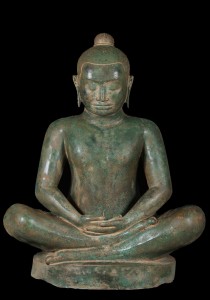
With regards to the arts, King Jayavarman VII was responsible for the construction of numerous temples in the Angkor region and in other provinces. King Jayavarman VII was further championed as the greatest king of Angkor for liberating and unifying the country. His legacy lives on today as many of the structures remaining today within Angkor Wat were built during his reign. At the center of Angkor Thom is the Bayon Temple, famous for its distinct 50 towers, each bearing the large faces of Bodhisattva Avalokiteshavara on all four sides. These faces are thought to be copied from the actual face of King Jayavarman VII, whose smiles are so gentle that it is often referred to as the Khmer smile. This great king was a devout Buddhist of the Mahayana sect.

